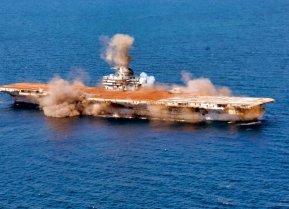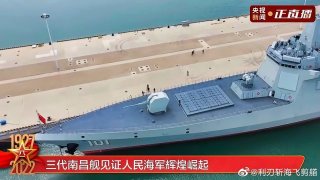China's Type 055 Renhai-Class Guided-Missile Cruisers Look Like a Powerhouse
The Type-055 Renhai-Class is expected to serve as the primary escort vessel for China’s growing fleet of aircraft carriers – making the function of the Renhai roughly analogous to the US’s Ticonderoga-class cruiser.tr
Meet the Type 055 Renhai-Class from China: While the merits of attempting to temper China’s rise are debatable, one debate seems settled: China is poised to (or already has) ended America’s unipolar moment. Indeed, China is poised to become a hegemon in Northeast Asia, and throughout the Indo-Pacific. Despite China’s rise, the US is safe – no country enjoys a geographic buffer from enemies or threats like the North American-based United States. And no country enjoys as plentiful an array of resources as the United States. And no country even comes close to investing the bounty of their resources into their defense budget like the United States – who spends nearly three times more on defense than China, and nearly ten times more on defense than Russia.
Still, China warrants special attention. Despite an ageing population, China boasts 1.4 billion citizens – more than any other nation. China’s latent economic potential is awesome. And China seems intent on revision, especially with respect to the Indo-Pacific, an industrial hub that is vital to the geopolitical balance of power.
Given China’s massive population, latent potential, and revisionist agenda, it makes sense that Xi Jinping has committed to bolstering his country’s military capacity. Obviously, China has the ability to field more troops than just about anyone else. But China is also working to improve their military technology. How? Through collaboration (imports and licensing) from the Russians. Through industrial espionage (of the Americans), and through the domestic development of homegrown technologies.
In recent years, China has fielded a variety of new weapons systems that have raised Western concerns. Hypersonic missiles, for example. Or fifth-generation fighters like the Chengdu J-20. The Type 003 Fujian aircraft carrier. And the Type 055 Renhai-class guided-missile cruisers, which are “amongst the most formidable warships afloat.”
Type 055 and Command of the sea
China is amidst one of world history’s most ambitious shipbuilding spree. Already, the Chinese have surpassed the United States for the claim to world’s largest navy. And while the US still maintains an advantage with respect to naval quality, if not naval quantity, the Chinese are bridging the qualitative gap.
China’s investment in its navy is strategic; China is asserting itself throughout the Indo-Pacific region, which requires a competent navy. Specifically, China is asserting claims to various territories throughout the region, engaging in open disputes with Indo-Pacific neighbors. To back up the various claims and disputes, China needs a competent seafaring force vessels like the Type 055 Renhai.
The Renhai “represent[s] the culmination of China’s efforts to build powerful long-range surface combatants to project power and escort the [People’s Liberation Army Navy’s] growing fleet of aircraft carriers.”
Equipped with stealth technology, the Renhai was designed to perform multiple missions, including air defense and anti-submarine warfare. The Renhai is expected to serve as the primary escort vessel for China’s growing fleet of aircraft carriers – making the function of the Renhai roughly analogous to the US’s Ticonderoga-class cruiser.
The specifications of the Type 055 Renhai-Class
The Renhai was built with a conventional flared hull with some distinct modifications – notably an enclosed forecastle that obscures mooring points, anchor chains, and other equipment – all for the purpose of lowering the Renhai’s radar cross section. The amidship was also designed to reduce the boat’s radar cross section, incorporating a continuous structure. And the Renhai’s smokestack was designed to reduce both the radar cross section and the infrared signature.
The Renhai is well equipped with offensive weaponry. “The Type 055 is armed with 112 universal vertical launch system (VLS) missile tubes, with 64 launchers fitted forward in an 8x8 configuration, and 48 launchers further aft in a 6x8 configuration,” The U.S. Naval Institute noted. “The universal launchers carry a mix of HHQ-9B surface-to-air missiles (SAMs), which have a range in excess of 100 nautical miles (nm), and YJ-18 antiship cruise missiles with a 290 nm range.” The Renhai is also understood to be able to carry antisubmarine missiles, and possibly, land-attack missiles, too. Additionally, the Renhai features one 130-mm gun and one 30-mm close-in weapon system (CIWS) forward of the bridge. Two triple 324-mm torpedo launchers are on board for anti-submarine warfare. The variety of weaponry on board hints at the versatility with which the Chinese intend to deploy the Type 055.
The Renhai can also house two maritime helicopters, lie the Harbin Z-9, which is based on the Eurocopter AS-365.
In all, the Renhai measures 590 feet long, with a 65 foot beam and a 21 foot draught. The boat displaces between 12,000 and 13,000 tons when fully loaded. For propulsion, the Renhai relies upon four gas turbines, which power two controllable-pitch propellers, allowing the Renhai to reach speeds of 30 knots, with an estimated range of 5,000 nautical miles.
About the Author
Harrison Kass is a prolific defense writer with over 1,000 published articles. An attorney, pilot, guitarist, and minor pro hockey player, Harrison joined the US Air Force as a Pilot Trainee but was medically discharged. Harrison holds a BA from Lake Forest College, a JD from the University of Oregon, and an MA from New York University. Harrison listens to Dokken.
Image Credit: Chinese Internet Screenshot VIA X.


